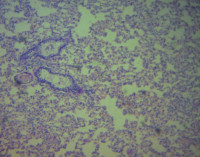Effects of Mosquito Coil Smoke Inhalation on the Haematological, Biochemical, and Histopathological Parameters of Wistar Rats (Rattus norvegicus) https://dx.doi.org/10.4314/njpar.v44i1.20
Main Article Content
Abstract
Malaria remains the most important mosquito-borne parasitic disease in sub – Saharan Africa and one of the ways of reducing the risk of the disease is by preventing mosquito–human contact. Mosquito coil (MC) is a coiled substance having one or more insecticides that slowly burns to emit smoke that repels mosquitoes. Some emissions from mosquito coil smoke (MCS) have however been reported to have various health implications. In this study, we investigated the effect of MCS inhalation on the haematological, biochemical, and histopathological parameters of Wistar rats. Twenty adults male Wistar rats weighing between 160 and 180g were divided into four groups of five rats each. Group I (G1) served as unexposed control while groups 2 – 4 (G2, G3, G4) were exposed to MCS for 2, 4, and 6 hours respectively each day for eight weeks. At the end of the exposure period, the rats were weighed and sacrificed. Blood samples were collected for haematological and biochemical parameters while kidney, liver and lung samples were harvested for histopathology. There was a significant increase (P<0.5) in the Packed Cell Volume (PCV) and electrolyte level of exposed rats compared to the control.
Histopathological evaluation of the kidney showed severe congestion of the renal cortex and moderate diffused degeneration of the renal tubules. Sections of the exposed liver showed mild to moderate periportal cellular infiltration, mild congestion of interstitial capillaries, and mild diffuse hydropic degeneration of hepatocytes. Similarly, sections of exposed lungs revealed severe congestion and oedema of the lungs, moderate diffuse proliferation of alveoli pneumocyte, multiple foci of congestion, and oedema with haemorrhage into the alveoli. These findings suggest that exposure to MCS may have toxic effects on the haematological, biochemical, and histopathological parameters of Wistar rats. Friendlier mosquito control alternatives like Long Lasting Insecticidal–treated Nets should therefore be encouraged.
Article Details

This work is licensed under a Creative Commons Attribution-NonCommercial-NoDerivatives 4.0 International License.
References
W H O ( 2 0 2 2 ) . Malaria[factsheet].https://www.who.int/newsroom/fact-sheets/detail/malaria (accessed 12 May 2022)
World Malaria report (2022). Tracking Progress and gaps in the global response to malaria. World malaria report 2022(who.int). Accessed January 14, 2023.
World Malaria report (2020). 20 years of global progress & challenges. World Malaria Report 2020 (who.int). Accessed January 14, 2023.
Okoh, H. I., Mogaji, H. O., Adekoya, M. A., Morikwe, U. C., Nwana, A. O., Ahmed, J., Makanjuola, W. A. and Otubanjo, O. A. (2020). Ethno-botanical survey of plant species used for mosquito control in Nigeria. Nigerian Journal of Parasitology, 42(1): 99 –
https://dx.doi.org/10.4314/njpar.v42i1.14
Strickman, D., Frances, S. P. andDebboun, M. (2009). Prevention of bug bites, stings, and disease, Oxford University Press, New York. 323 pp. ISBN 970-0-19-536577-1
Garba, S. H., Shehu, M. M., and Adelaiye, A. B. (2007). Toxicological Effects of Inhaled Mosquito Coil Smoke on the Rat Spleen: A Haematological and Histological Study. Journal of Medical Sciences, 7(1):94 -99.
Okoh, H. I., Adekoya, M. A., Makanjuola, W. A, Otubanjo, O. A., and Awolola, S.(2016). Repellent activities of essential oils from ten Nigerian plant species against laboratory–bred and field–collectedAnopheles gambiae and Aedes aegyptiadults. Nigeria Journal of Clinical and Biomedical Research, 7(6): 21 – 31.
Odukanmi, O. A., Salami, A. T.,Olanrewaju, T. R. and Olaleye, S. B. (2020). Exposure to mosquito coil smoke delays healing of acetic acid-induced gastric ulcer in male Wistar rats. Nigerian Journal of Physiological Sciences, 35:77-87.
Kurawa, M. I., Magaji, R. A., Yusuf, T. and Magaji, M. G. (2020). Effects of Mosquito coil Smoke Inhalation on Spatial Memory in Mice. Nigerian Journal of physiological sciences: official publication of the Physiological Society of Nigeria, 35(1), 68–76.
Keshava, N. and Ong T. (1999).Occupational exposure to genotoxic agents. Mutation Research, 155:117-120.
Wolansky, M. J. and Harrill, J. A. (2008). Neurobehavioral toxicology of pyrethroid insecticides in adult animals: a critical review. Neurotoxicology and teratology 30(2): 55 – 78. doi:10.1016/j.ntt.2007.10.005
Fagbule, D. and Ekanem, E. E. (1994): Some environmental risk factors forchildhood Asthma: A case-control study. Annals of Tropical Pediatrics, 14(1):15-9.
Okine, L. K. N., Nyarko, A. K., Armah, G. E., Awumbila, B., Owusu, K., Set-Sofia S. and Ofosuheme, M. (2004). Adverseeffects of mosquito coil smoke on lung, liver and certain drug metabolizing enzyme in male Wister albino rats. Ghana Medical Journal, 38: 89-94
Garba, S. H., Adelaiye, A. B. and Mshelia, L. Y. (2007). Histopathological andbiochemical changes in the rats kidney following exposure to a pyrethroid-based mosquito coil. Journal of Applied Sciences Research, 3(12):1788-1793
Bain, B. J., Bates, I. and Laffan, M. A. (2017). Dacie and Lewis practicalhaematology. 12th Edition, Elsevier Health Sciences, 600 pp.
Elekwa, I., Ude, V. C., Emmanuel, O., Amachaghi, V. O. and Ugbogu, E. A. (2021). In vivo studies on the ameliorative effect of coconut water against carbon tetrachloride-induced toxicity in rats. Biomarkers, biochemical indicators ofexposure, response, and susceptibility to
chemicals, 26(6): 570 – 577. doi:10.1080/1354750X.2021.1946848
Yadav, S., Kumar, R. D., Rani, A., and Chopra, J. (2021). Effect of inhalation of pyrethroid-based mosquito vaporizers fumes on the body weight of male albino Wistar Rats. An experimental study. Journal of Clinical and Diagnostic Research, 15(4): AC01-AC03.
Fan, W., Yanase, T., Morinaga, H., Gondo, S., Okabe, T., Nomura, M., Komatsu, T., Morohashi, K., Hayes, T. B., Takayanagi, R. and Nawata, H. (2007). Atrazineinduced aromatase expression is SF-1 dependent: implications for endocrinedisruption in wildlife and reproductive cancers in humans. Environmental Health Perspectives, 115(5): 720–727. doi:10.1289/ehp.9758
Karim, M. R., Ghose, D. K., Rahman, M. A., Hossain, M., and Islam, R. (2020). Evidence of health complications caused by mosquito coil smoke inhalation in mouse model. Journal of Advance Biotechnology and Experimental Therapeutics, 3(2):122-127.https://doi.org/10.5455/jabet.2020.d11 6
Jose, H. S. (2014). Overview of urea and creatinine. Laboratory medicine, 45(1): e19–e20.
Halliwell, B. and Gutteridge, J. M. C. (1999) Free Radicals in Biology andMedicine. In: Halliwell, B. and Gutteridge, J.M.C., Eds., Free Radicals in Biology and Medicine, 3rd Edition, Oxford University Press, Oxford, 1-25.


